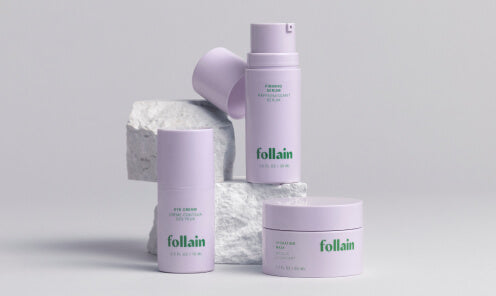By Lauren Wolk-Goldfaden, VP of Sales at Goldfaden MD
Exfoliation (why it matters)
Out with the old, meaning skin cells that are needlessly hanging around, dulling things up - and in with the new, ready-to-glow skin that was just waiting to emerge. Exfoliation is literally one of the best things you can do for your skin. Start clean. Start new. Start exfoliating, like yesterday.
But first…choose your weapon wisely….
Ever wonder why a baby’s skin is so soft? It’s because babies naturally replace their skin cells every few days. As you grow older, however, the rate of skin cell turnover slows down dramatically. Dead cells linger on your skin’s surface longer. The average life of a healthy cell is 28 days, but as time goes by, this cycle naturally slows…this is where exfoliation comes in. By exfoliating regularly, you can help remove the excess skin that leads to dullness and even an accentuation of fine lines. By removing these dead skin cells, exfoliation helps the natural skin renewal process, improving the tone and texture of your skin almost instantly.
The process of exfoliation is a lot like peeling away the dry, outer skin of an onion to reveal the living layers beneath. Whether the exfoliation is done using physical or chemical exfoliation (more on that in a bit), removing dead and damaged skin cells on the surface allows the fresh new, and your softest skin underneath to become visible. Newly smooth skin’s surface reflects light better, making fine lines and other small imperfections harder to see. Age spots and other areas of unwanted pigmentation are less noticeable because the dead skin cells containing the pigment have been removed. Exfoliation unplugs clogged pores and allows for the release of natural skin oils.
Regular exfoliation (i.e. weekly) also helps to maintain open pores, decrease pore size, and minimize the appearance of many types of superficial scarring. In addition, removing the top layer of dead and damaged cells allows other health-promoting agents such as moisturizers, antioxidants, and collagen-boosting ingredients to better penetrate the skin and work more effectively. In short, it’s time to start exfoliating if you’re not already doing so!
Choosing the right exfoliator for your skin type
Choosing the proper exfoliator is a personal preference and a balancing act. The first step is identifying the skin concern or the ‘problem’ that you want to solve. For example, acne-prone skin will do better with one type of exfoliator, while sun-damaged, pigmented skin will do better with another. Listen to your skin – if it appears dry, red or irritated, it’s time to find a new exfoliator. And always remember not to over-exfoliate skin that’s been exposed to the sun or the sea on a particular day, as this may cause undue redness or irritation.
Physical exfoliants (scrubs) are extremely effective at targeting fine lines, pigmentation, acne, skin tone and roughness. A scrub must utilize an exfoliation vehicle that does not harm the skin, break capillaries or cause redness.
Our Doctor's Scrub Exfoliator is so effective due to the Ruby crystals that are used. Ruby Crystals are perfectly round and have no jagged edges like sugar or salt-based scrubs. Doctor's Scrub also contains hydrating emollients, Hyaluronic Acid, Jojoba Oil and Apricot Kernel oil, all of which hydrate and nourish the skin. The outcome? Glowing, plumped, gorgeously clear skin.


Scrubs can be used 2-4 times per week depending on the level of skin sensitivity.
TIP: To allow for a less aggressive treatment, simply mix with a cleanser to dilute the product and carry on. A good game plan for sensitive skin or those who like to exfoliate often.
Chemical exfoliants (peels or wipes) are acid and enzyme-based vehicles, which are also very effective against certain skin concerns. Think AHA’s like fruit or sugar enzymes, and BHA’s like saliylic acid. Chemical exfoliators are very appropriate for people that suffer from sun damage, hyper-pigmentation and wrinkles. In general, beta hydroxy acid is a more effective treatment for acne prone skin.
Lactic acid (found in our Fresh A Peel Multi-Acid Resurfacing Peel) is extremely beneficial for sun damaged skin, dark spots and hyper-pigmentation. Lactic acid molecules are larger than Glycolic molecules, so they don’t go as deep as quickly, therefore targeting the top layers of the skin (where the darkness appears). Fruit enzymes such as lemon, grapefruit and orange, contain high properties of Vitamin C which aids in skin brightening, keeping discoloration at bay, and help to cleanse, purify and detoxify the skin. People with very sensitive skin, including rosacea and eczema, should look for facial exfoliators that are enzyme-based because enzymes soften and break up the surface layer dead skin and work to brighten the overall complexion without causing any redness/irritation.
How To: A 411 guide to exfoliation
Regardless of the exfoliator type – physical, pad, enzyme mask, you always want to start with a clean complexion. Use your favorite cleanser to ensure that all the makeup, dirt, oils and bacteria are cleansed away before beginning.
Apply your favorite cleanser onto damp skin and massage with two fingers in circular motions starting on your forehead, moving outward toward your temples, gently around your eyes a few times, and then downward along the nose, cheeks, jawline, neck, and chest. This deep cleansing motion across your complexion also helps increase circulation, reduce tension and provides you with a lovely relaxing facial massage.
When mechanically exfoliating (i.e. using a scrub or a tool), it's important to be gentle on your skin – you don’t need to add much pressure – let the product do the work itself. You can make small, circular motions using your finger around the entire facial area for about 30 seconds. Always rinse off with lukewarm — not hot — water as hot water can dry out your skin.
TIP: When using a mechanical/scrub exfoliating agent, you can always add in a pump or two of your favorite cleanser (one that is free of any enzymes like Salicylic or Glycolic acids as you don’t want to over exfoliate) to create a lighter exfoliating treatment. This allows for one to use more frequently without causing irritation or the known “over exfoliating” term and also is appropriate for one who has a more sensitive complexion.
Sunburn Alert: Use sunscreen, wear protective clothing, and limit sun exposure after use.
Using both a chemical and physical exfoliator:
The most important thing to remember in either choosing to use a physical or chemical exfoliator is to simply avoid overuse which causes redness and oftentimes irritation. While one (not everyone) can benefit from both physical and chemical exfoliation, if using both types of products within your regimen, it’s important to differentiate by following a few simple rules.
1. Avoid using a physical and chemical exfoliator on the same day
2. Space out between treatments
3. Listen to your skin and what it needs
When “out with the old” becomes part of your routine, those dead skin cells simply won’t stand a chance. Your fresh new face has been waiting…trapped under dullness that nobody needs. Find your exfoliator - and what you’ll find is the skin you were born with. Hello baby.
Meet Lauren...

Born and raised in Chicago, Lauren Wolk-Goldfaden grew up with a passion for all things beauty. After discovering the lack of quality dermatological, natural skincare products, she was propelled into creating a solution. As VP of Sales, Lauren has since helped build GOLDFADEN MD into an internationally-recognized and respected naturally based skincare brand.













